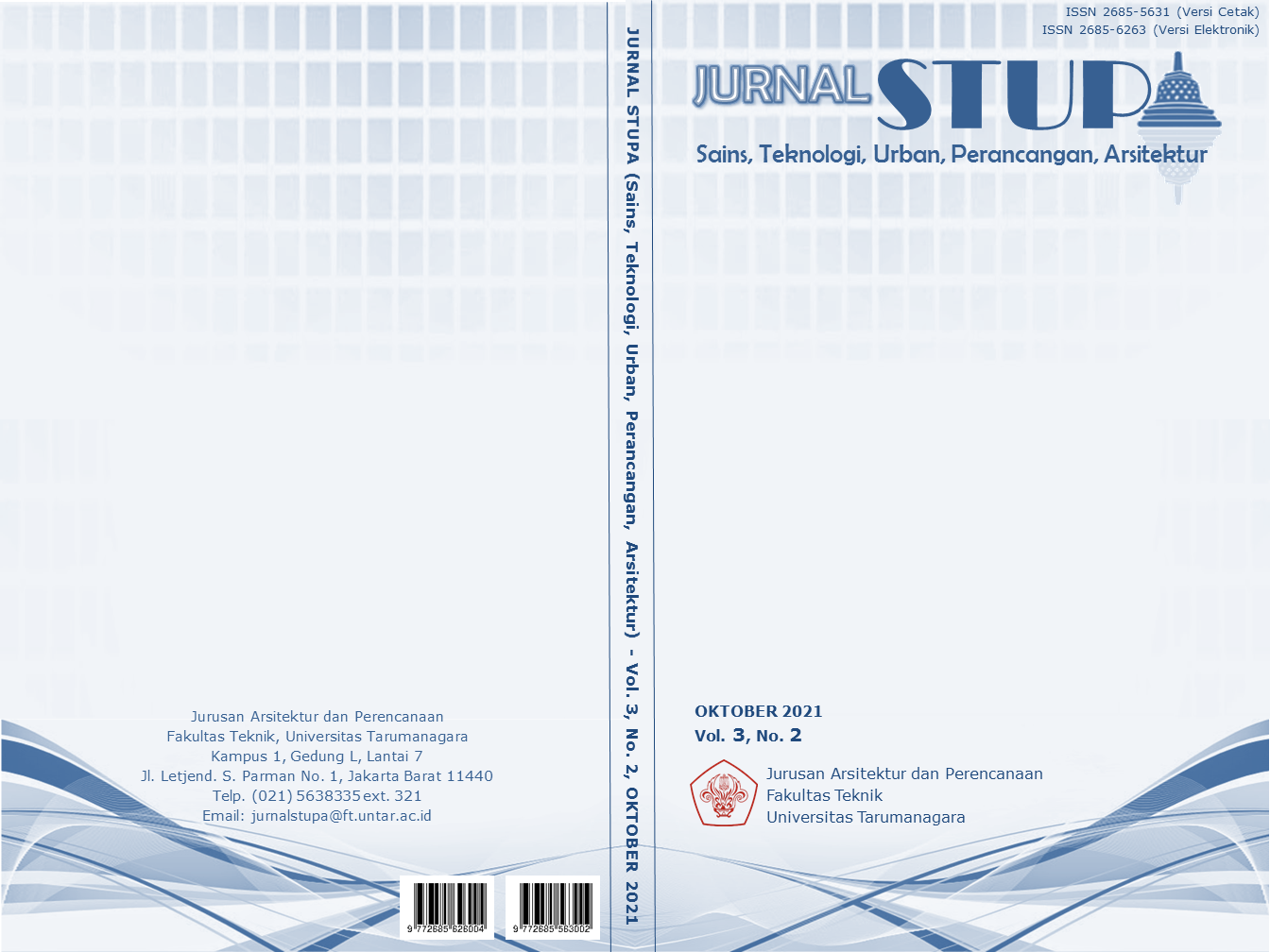PERAN AKTIF ARSITEKTUR DALAM MEMBENTUK POLA PERILAKU MASYARAKAT YANG SADAR LINGKUNGAN MELALUI PERSEPSI RUANG
Main Article Content
Abstract
Eventually, whether consciouslly or not, we humans keep ignoring nature and the environment as if they’re not more impactable than us. Meanwhile, the products we consumed are mostly made/created from natural sources. In this case, it is necessary to give a proper understanding of nature-aware. Architecture as part of our daily life has an active role in creating a character with environmental consciousness. Approaching AQAL’s four quadrants of consciousness and trans-theoretical model expressed in spatial perception, hopefully, this project could develop human’s natural consideration on behaving which also affects those around them. Each quadrant’s unique psychological character is translated to supporting activities. Some motoric-stimulatic activites provokes social interaction between visitors, which is suitable to be put at open areas. The activities implied can be integrated with schools’ extracurricular programs, work as research objects, and refreshment recreational attractions in this crowded city area. This project is targetting primary ages with the hope that they can show a positive character and develop better ones later.
Keywords: behavioral architecture; environmental consciousness; spatial perception
Abstrak
Dalam menjalankan kehidupan, secara sadar ataupun tidak, kerap kali lingkungan menjadi pihak yang dirugikan oleh perilaku manusia. Sedangkan, produk-produk yang dikonsumsi manusia bersumber dari alam. Dalam hal ini, perlu adanya masukkan pemahaman kepada masyarakat untuk semakin sadar akan lingkungan di sekitarnya. Arsitektur, sebagai wadah kegiatan, dapat berperan aktif dalam membentuk karakter masyarakat yang sadar akan lingkungan. Dengan pendekatan empat kuadran AQAL (All Quadrants All Levels) dan model transteoritikal, proyek ini diharapkan dapat menumbuhkan cinta kasih terhadap lingkungan melalui permainan persepsi ruang. Kombinasi karakter setiap kuadran yang menunjukkan sisi psikologis individu diterjemahkan menjadi jenis aktivitas dengan sifat yang mendukung. Aktivitas motorik yang dapat menjadi stimulus interaksi sosial menjadi perantara antarkegiatan. Program proyek dapat diintegrasikan dengan ekstrakurikuler sekolah dasar, menjadi objek penelitian, serta tujuan rekreasi dan bersantai.
Article Details
References
Burnie, D. (2005). Bengkel Ilmu: Ekologi. Jakarta: Erlangga.
Cañas, P. M. (2019, April 8). The understanding of the body and movement in Merleau-Ponty1. doi:10.1590/0101-3173
CapeSpace. (n.d.). How the 21/90 rule helps you build good habits and a better life. Retrieved from CapeSpace: https://www.capespace.com/how-the-21-90-rule-helps-you-build-good-habits-and-a-better-life/
Hudha, A. M., Husamah, & Rahardjanto, A. (2018). Etika Lingkungan (Teori dan Praktik Pembelajarannya) (Cetakan Pertama ed.). Malang, Indonesia: Universitas Muhammadiyah Malang.
Prochaska, J. O. (1982). Transtheoretical therapy: Toward a more integrative model of change. Psychotherapy: Theory, Research & Practice, 19(3), 276-288.
Velasquez, M., Andre, C., Shanks, T., Meyer, M. J., & S.J. (2010, January 1). What is Ethics? Retrieved from https://www.scu.edu/ethics/ethics-resources/ethical-decision-making/what-is-ethics/
Watling, T. (2011). Ecological Imaginations in the World Religions. Continuum.
Wilber, K. (1997). An Integral Theory of Consciousness. Journal of Consciousness Studies(4), 71-92. Retrieved February 17, 2020, from http://www.newdualism.org/papers/K.Wilber/Wilber-JCS1997.pdf


